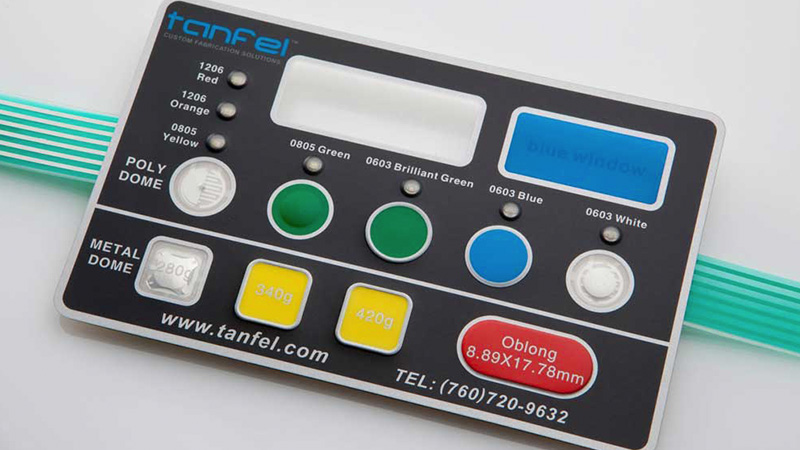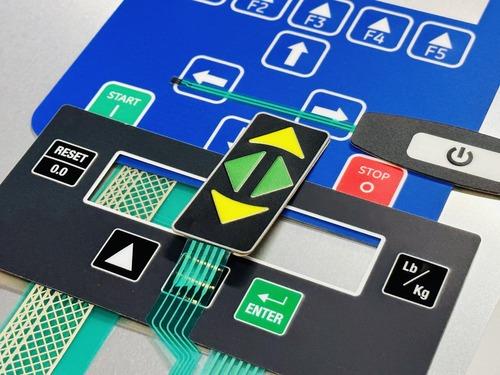Choosing the Right Membrane Switches for Your Product’s Needs
Choosing the Right Membrane Switches for Your Product’s Needs
Blog Article
Discover How Membrane Switches Function and Their Duty in Modern Electronic Devices
Membrane Switches stand for an advanced combination of technology and design within the world of contemporary electronics, functioning as essential user interfaces in many devices. Comprised of numerous layers, these switches make use of pressure-sensitive systems to help with customer communication. Their applications span numerous markets, from customer electronics to clinical devices, highlighting their versatility and relevance. Comprehending the complexities of Membrane switch capability and their broader effects in improving customer experience invites further exploration right into their design, benefits, and the innovative growths shaping their future in modern technology.
What Are Membrane Switches?

Membrane switches are distinguished by their durability and resistance to ecological aspects, such as dust, moisture, and severe temperature levels. They can be personalized with various graphics, shades, and responsive responses choices, enhancing customer experience while keeping visual charm - membrane switches. The consolidation of published circuits enables for smooth combination into gadgets, boosting overall capability.
The adaptability of Membrane buttons appears in their capacity to support both complicated and easy control functions. They can incorporate functions such as LED indications and touch-sensitive innovation, catering to certain individual needs. As innovation remains to advance, Membrane Switches continue to be necessary for enabling effective and instinctive interface, consequently playing a pivotal function in the development of contemporary electronic devices.
Parts of Membrane Switches
Membrane buttons are made up of numerous vital elements that work with each other to develop a reputable and practical user interface. The primary elements include the graphic overlay, sticky layer, spacer layer, and conductive traces.
The visuals overlay functions as the user interface, usually published on a flexible substrate such as polyester or polycarbonate. This layer not just supplies visual appeal but also consists of tactile responses, aesthetic signs, and safety features. Beneath the visuals overlay exists the adhesive layer, which secures the switch to the tool and makes certain resilience against ecological anxieties.
The spacer layer is vital for keeping the essential space between the graphic overlay and the circuit layer. This space enables for the activation of the switch when stress is applied. The conductive traces, generally made from silver or carbon, form the electric pathways that finish the circuit when the button is involved.
Furthermore, a backing layer might be consisted of for architectural support and insulation. These components team up seamlessly, guaranteeing that Membrane switches are both user-friendly and resilient, making them vital in various modern digital applications.
Exactly How Membrane Switches Work
Exactly how do Membrane Switches feature successfully within digital tools? Membrane Switches run on the concepts of pressure-sensitive technology, utilizing a split building and construction that consists of graphic overlays, adhesive layers, and conductive elements.
The design of Membrane switches is essential for their efficient operation (membrane switches). The layers are diligently crafted to give responsive comments, sturdiness, and resistance to environmental elements such as wetness browse around this site and dust. The inclusion of domes-- tiny, increased areas within the button-- enhances responsive action, offering users with a noticeable click experience upon activation
Additionally, Membrane buttons can be personalized in terms of dimension, shape, and graphics, making them ideal for different applications. They are frequently made use of in control panels, medical devices, and customer electronics as a result of their smooth layout and dependability. Overall, the effective functioning of Membrane switches is essential in enhancing customer interaction and making certain seamless procedure in modern digital devices.

Applications in Modern Gadgets
Using their unique style and capability, Membrane switches have come to be integral components in a wide variety of contemporary digital tools. These versatile interfaces are utilized in consumer electronics, commercial devices, medical devices, and vehicle controls, giving seamless user interaction.
In consumer electronic devices, Membrane buttons are commonly discovered in devices like microwaves, washing machines, and other home gadgets, where they make it possible for user-friendly control with a smooth profile. Their low-profile design helps with combination into small gadgets, improving aesthetic appeal without compromising performance.
In industrial applications, Membrane Switches serve as control panels for machinery, offering toughness and resistance to extreme atmospheres. Their capability to endure wetness and contaminants makes them perfect for use in production and processing sectors.
Clinical gadgets also take advantage of Membrane buttons, which are made to be very easy to clean and maintain, ensuring health in professional setups. They are typically used in analysis devices, client monitoring systems, and mobile medical devices, where integrity is extremely important.
Benefits of Membrane Switches
Among the essential benefits of Membrane buttons is their convenience, which allows them to be tailored for a range of applications throughout several industries. These buttons can be made in different sizes and shapes, fitting special product demands while giving seamless integration right into devices. Their thin profile makes it possible for a streamlined and compact design, usually enhancing the visual allure of digital items.
Another significant advantage is their sturdiness - membrane switches. Membrane buttons are generally resistant to dust, moisture, and chemicals, making them excellent for severe settings. This resilience prolongs their lifespan compared Resources to standard mechanical switches, minimizing the need for constant substitutes
In addition, Membrane Switches deal cost-effectiveness. The production procedure entails printing technologies that reduce manufacturing expenses, specifically for large runs. This affordability, incorporated with low upkeep demands, makes them an eye-catching choice for producers.

Conclusion
In final thought, review Membrane Switches represent a significant improvement in user interface innovation within modern-day electronic devices. As the need for instinctive and resistant user interfaces proceeds to grow, the function of Membrane switches in shaping user experience will unquestionably expand.
Membrane Switches represent an innovative integration of modern technology and layout within the world of modern-day electronics, serving as essential interfaces in countless devices.In the world of contemporary electronics, Membrane Switches offer as vital elements that promote individual interaction with gadgets. As modern technology continues to evolve, Membrane Switches remain necessary for enabling reliable and instinctive individual interfaces, thereby playing a critical function in the improvement of modern electronic gadgets.
Exactly how do Membrane Switches feature efficiently within electronic devices? Overall, the efficient performance of Membrane buttons is crucial in improving individual communication and ensuring smooth procedure in modern-day electronic tools.
Report this page